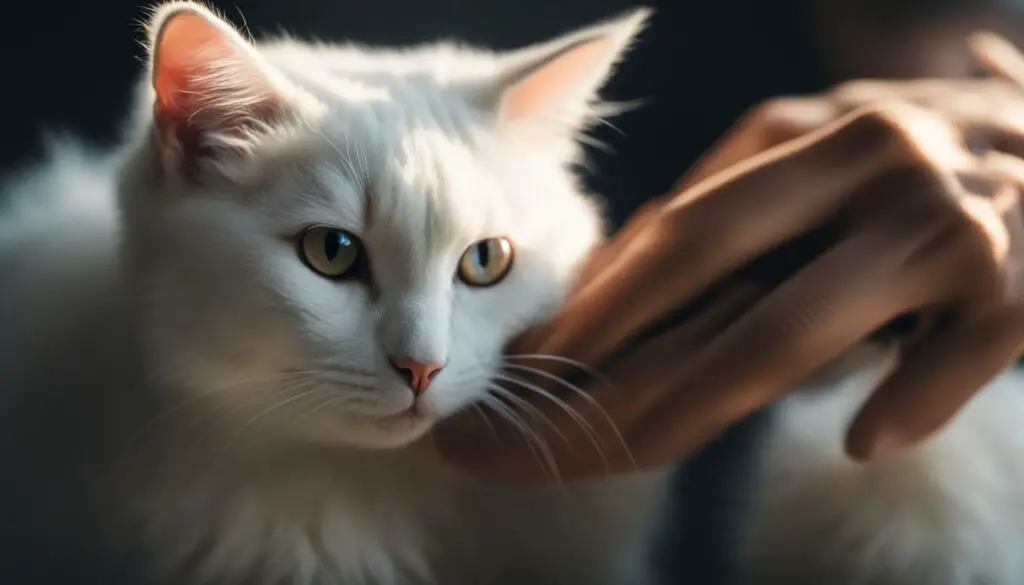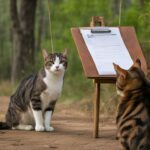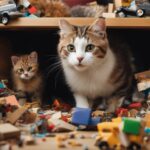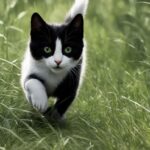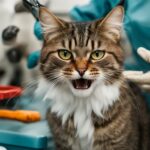Welcome to our article on picking up cats by scruff, a widely debated cat handling technique. In this article, we will delve into different perspectives on this method and explore alternative approaches that prioritize safety and cat comfort.
Scruffing involves picking up a cat by the loose skin on the back of its neck, mimicking how a mother cat carries her kittens. While commonly used in veterinary settings, its appropriateness and effectiveness with adult cats are subjects of ongoing discussion.
Understanding feline behavior is crucial when considering cat handling techniques. Safety measures and the well-being of our feline friends should always be our top priorities. In this article, we will explore the science behind scruffing, its use in veterinary settings, and the impact it can have on cat health and welfare.
We will also discuss alternative methods for cat handling that promote stress reduction and positive experiences for both cats and their caregivers. Additionally, the role of caretakers in building trust and fostering a strong patient-cat relationship will be highlighted.
Stay with us as we explore the intricacies of cat handling and its impact on cat welfare and the human-feline bond.
Key Takeaways:
- Picking up cats by scruff is a debated cat handling technique that mimics how a mother cat carries her kittens.
- Feline behavior, safety measures, and cat comfort should guide our approach to cat handling.
- Understanding the science behind scruffing and its impact on cat health and welfare is important.
- Alternative methods, such as scruff-free handling and Fear Free techniques, prioritize stress reduction and cat well-being.
- The role of caretakers in building trust and enhancing the patient-cat relationship cannot be underestimated.
The Science Behind Scruffing
Scruffing is a commonly used handling technique for cats, particularly in veterinary settings. This method involves picking up a cat by the loose skin on the back of its neck, mimicking how a mother cat carries her kittens. While the exact mechanism behind this technique is not fully understood, it is believed to activate specific pathways in the cat’s nervous system. Scruffing is thought to trigger a response similar to the release of endorphins, which can help facilitate safe transport and handling of cats.
Scruffing is an evolutionary adaptation that takes advantage of a reflex seen in kittens. When a mother cat picks up her kittens by the scruff of their neck, it triggers a freeze response and helps to calm the kittens. This reflex is believed to carry over into adulthood, but its effectiveness can vary among individual cats. Scruffing may be more appropriate for young cats or kittens, as they are more likely to have a stronger response to this handling technique.
| Advantages of Scruffing | Disadvantages of Scruffing |
|---|---|
| Facilitates safe transport | Effectiveness varies among individual cats |
| Can be used in veterinary procedures | May cause discomfort in adult cats |
| Triggers a calming reflex | Can potentially escalate stress levels |
Table: Advantages and disadvantages of scruffing as a cat handling technique
While scruffing can be an effective and safe technique in certain situations, it is essential to assess each cat individually and consider alternative methods that prioritize their comfort and well-being. Veterinary professionals are increasingly adopting scruff-free handling approaches that focus on reducing stress and providing a more positive experience for cats. These alternative techniques may include wrapping cats in towels, using Fear-Free methodologies, or conducting exams while cats remain in their carriers. By understanding the science behind scruffing and exploring alternative handling techniques, we can continue to improve the care and welfare of our feline companions.
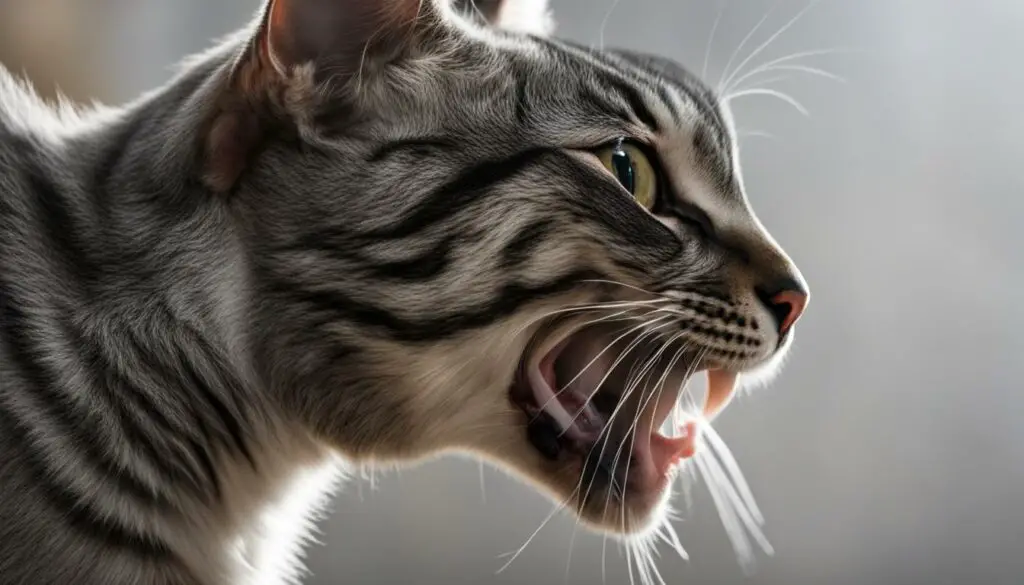
The Role of Endorphins in Scruffing
One of the key aspects of scruffing is its potential to trigger the release of endorphins in cats. Endorphins are naturally occurring chemicals in the body that act as pain relievers and induce a sense of well-being. When a cat is scruffed, it is believed to activate specific pathways in the nervous system, leading to the release of endorphins. This can help to calm the cat and reduce stress levels. However, further research is needed to fully understand the mechanisms behind this process and its impact on different cats.
Cat Restraint in Veterinary Hospitals
In veterinary hospitals, ensuring the safety of both the staff and the cat during procedures is of utmost importance. Cat restraint techniques, including scruffing, are sometimes necessary to minimize the risk of injury and enable efficient treatment. However, it is essential to recognize that not all cats respond positively to scruffing and that alternative methods may be required to ensure their well-being.
When a cat has a negative reaction to scruffing or shows signs of stress or fear, sedation can be used as a safer alternative. Sedation helps lower stress levels, allowing veterinary staff to work with minimal risk to themselves and the cat. By administering sedatives, cats can undergo necessary procedures in a more comfortable and relaxed state, promoting their overall well-being.
Each cat should be assessed individually to determine the most appropriate method of restraint. The goal is to choose a technique that minimizes stress and provides a safe environment for both the cat and the veterinary team. When selecting a method, factors such as the cat’s temperament, previous experiences, and the specific procedure being performed should be taken into account. This personalized approach ensures that the cat’s welfare is prioritized throughout their veterinary care.
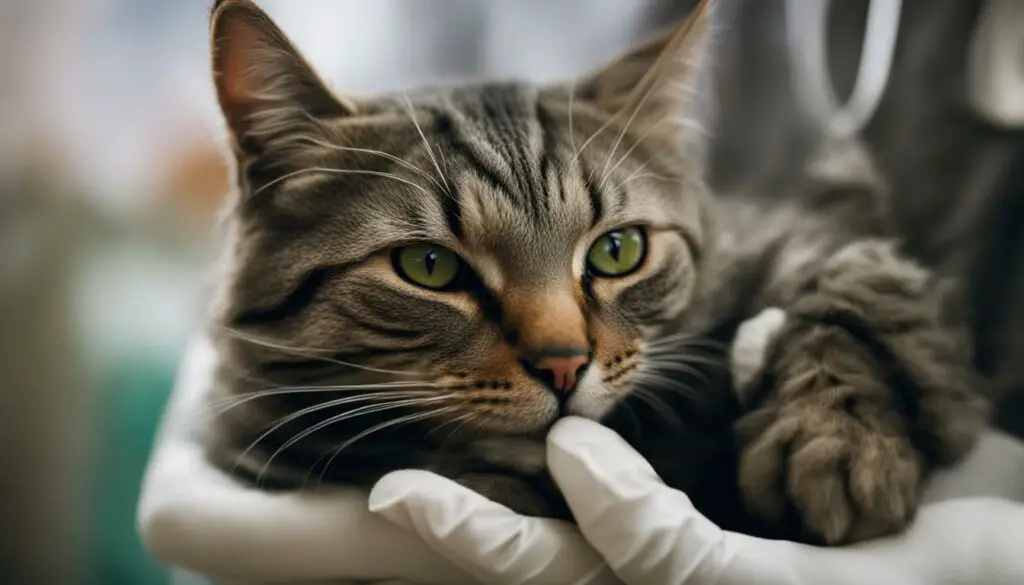
The Importance of Safety and Minimal Risk
Cat restraint techniques in veterinary hospitals aim to ensure the safety of both the cat and the staff. Safety measures should be implemented to minimize the risk of injury or escalation of stress during procedures. This includes using appropriate equipment, such as gloves, scruffing tools, and protective clothing, as well as employing trained staff who are knowledgeable in handling cats.
| Benefits of Proper Cat Restraint in Veterinary Hospitals: | Potential Risks of Improper Cat Restraint in Veterinary Hospitals: |
|---|---|
|
|
By prioritizing safety and minimal risk in cat restraint procedures, veterinary hospitals can ensure that cats receive the necessary care while minimizing their stress and discomfort. When performed correctly, cat restraint techniques can contribute to a positive veterinary experience and promote the overall well-being of feline patients.
Scruff-Free Handling: A New Approach
When it comes to cat handling, a new approach called scruff-free handling is gaining momentum. This alternative method prioritizes cat welfare and aims to reduce stress during veterinary visits and other handling situations. Scruff-free handling recognizes that cats may experience increased stress when their option to retreat is taken away and their sense of control is compromised. By adopting less intrusive approaches, such as wrapping cats in towels or conducting exams while they remain in their carriers, veterinary staff can create a more positive and comfortable experience for cats.
International Cat Care has launched a campaign advocating for scruff-free handling techniques. This campaign emphasizes the importance of reducing stress and promoting respectful handling practices in veterinary settings. By avoiding scruffing, which can potentially escalate stress levels and trigger anxiety in cats, veterinarians and cat owners can enhance the overall well-being of feline patients.
“Scruff-free handling recognizes that cats may experience increased stress when their option to retreat is taken away and their sense of control is compromised.”
Instead of scruffing, the scruff-free approach encourages the use of Fear Free techniques, which focus on creating a calm and stress-free environment for cats. Wrapping cats in towels can provide a sense of security and comfort, allowing them to feel more at ease during examinations or procedures. Additionally, conducting exams or treatments while cats are still in their carriers, with top openings, can provide a familiar and safe space for cats, reducing their stress levels.
By implementing scruff-free handling techniques, veterinarians and cat owners can prioritize the well-being of cats and foster a positive relationship based on trust and respect. This approach not only improves the handling experience for cats but also contributes to a more positive overall veterinary experience for both cats and their caregivers.
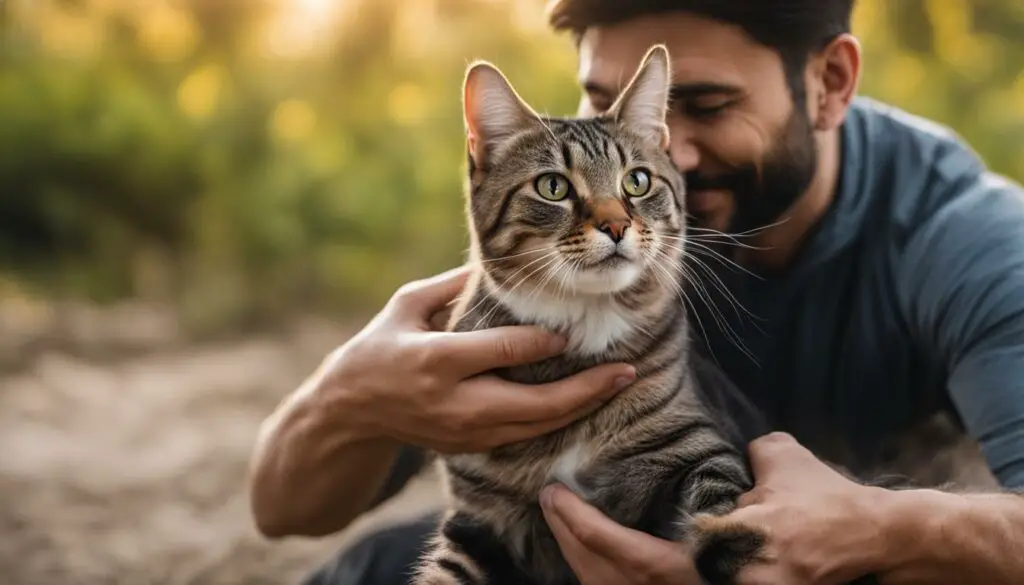
Scruffing and Cat Stress
The handling technique of scruffing can potentially lead to increased stress levels in cats due to their territorial instincts and suspicion of unfamiliar situations. When cats are scruffed, their option to retreat is taken away, and their sense of control is compromised. This can trigger a stress response, which may manifest as aggression or fear. To minimize stress and promote better overall well-being in cats, it is important to avoid scruffing and provide them with some sense of control over the situation.
Allowing cats the option to retreat and maintaining their sense of control can help reduce stress and anxiety. By respecting their boundaries and preferences during handling, we can create a more positive environment for cats. This can be achieved by using alternative handling techniques such as towel wrapping or conducting examinations while cats remain in their carriers. These methods provide a greater level of comfort and allow cats to feel more secure in their surroundings.
“Cats have territorial instincts and an inborn suspicion of unfamiliar people and settings.”
By prioritizing the cats’ comfort and well-being, we can help minimize stress and create a more positive handling experience. This can have a significant impact on their overall health and happiness. It is essential to consider the individual needs and preferences of each cat and adapt our handling techniques accordingly. By doing so, we can establish a foundation of trust and strengthen the bond between cats and their caretakers.
Scruffing and Cat Stress: A Visual Representation
| Scruffing | Alternative Methods | |
|---|---|---|
| Stress | Increased | Reduced |
| Aggression | Potential | Less likely |
| Option to Retreat | Taken away | Maintained |
| Control | Compromised | Preserved |
Table: A comparison of scruffing and alternative handling methods in relation to cat stress, aggression, option to retreat, and control.
The Impact of Scruffing on Cat Health and Welfare
Scruffing, as a cat handling technique, can have both behavioral and physiological effects on cats. Research conducted by the University of Guelph has shown that full-body restraint, including scruffing, can lead to negative behavioral responses in cats. During full-body restraint, cats may struggle more, exhibit pupil dilation, and experience an increased respiratory rate. Additionally, cats that have been scruffed are more likely to show signs of stress and attempt to escape after being released.
This study highlights the importance of welfare assessment when considering different handling techniques for cats. Scruffing may not be the most suitable method for all cats, especially those that find it uncomfortable or stressful. It is crucial to evaluate the individual responses of cats to scruffing and other handling techniques to ensure their well-being and minimize unnecessary stress.
To provide a comprehensive understanding of the impact of scruffing on cat health and welfare, further research and studies are needed. By continually improving our knowledge of feline behavior and refining our handling techniques, we can create a nurturing environment that prioritizes the comfort and trust of cats.
| Effects of Scruffing on Cats | Scruffing | Passive Restraint |
|---|---|---|
| Struggling | Increased | Decreased |
| Pupil Dilation | Present | Absent |
| Respiratory Rate | Increased | Normal |
| Signs of Stress | More likely | Less likely |

“Scruffing may not be the most suitable method for all cats, especially those that find it uncomfortable or stressful.”
Alternative Methods for Cat Handling
In response to the ongoing debate surrounding the appropriateness and effectiveness of scruffing in cat handling, alternative methods have emerged that prioritize the comfort and well-being of cats. These approaches aim to reduce stress and create a more positive experience for both cats and their caregivers. Adopting a “less is more” approach, towel wrapping, Fear Free techniques, mindful handling, and top-opening carriers are recommended as alternative methods for cat handling.
Using towel wrapping as a handling technique can help provide a sense of security for cats during veterinary exams or procedures. Wrapping them gently in a towel can help promote relaxation and reduce stress. Additionally, Fear Free techniques focus on creating a fear-free environment by eliminating triggers and using positive reinforcement to build trust and cooperation.
Mindful handling techniques involve paying attention to a cat’s body language and providing them with choices and control over their environment. This approach allows cats to feel more comfortable and secure during handling. Using top-opening carriers instead of traditional front-opening ones can also help reduce stress and make it easier to handle cats without the need for scruffing.
By embracing these alternative methods, both veterinary professionals and cat owners can ensure that cat handling is a positive and stress-free experience. These techniques not only promote the well-being of cats but also strengthen the bond between humans and their feline companions.
| Alternative Methods for Cat Handling | Benefits |
|---|---|
| Towel wrapping | – Provides a sense of security – Reduces stress – Promotes relaxation |
| Fear Free techniques | – Creates a fear-free environment – Builds trust and cooperation – Reduces anxiety |
| Mindful handling | – Respects cat’s boundaries – Provides choices and control – Increases comfort |
| Top-opening carriers | – Easier and less stressful handling – Provides a safer and more secure transport option |
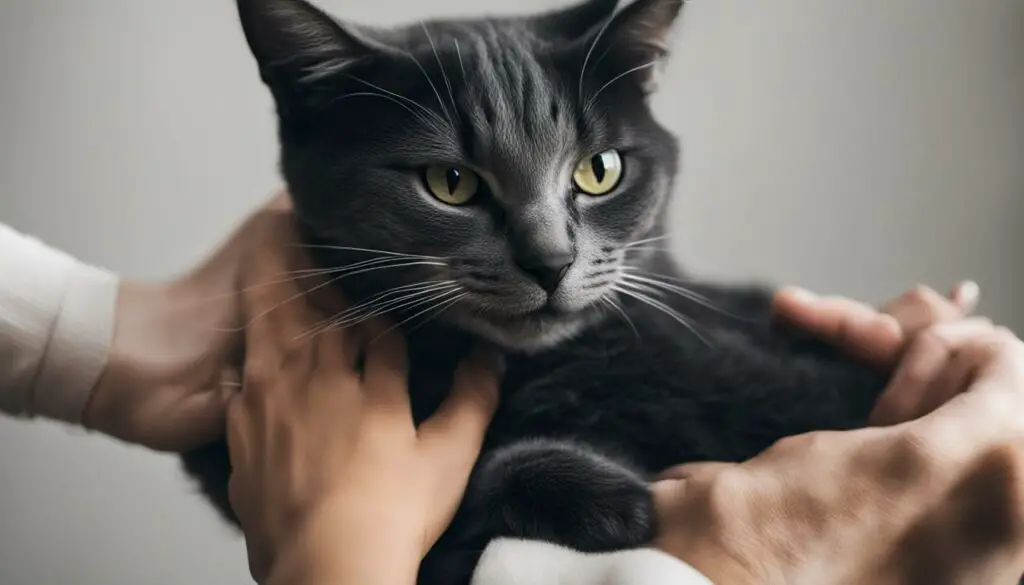
Enhancing Cat Handling in Veterinary Practice
To improve the welfare of cats in veterinary practice, several key factors need to be considered. First and foremost, staff training plays a crucial role in ensuring that veterinary professionals are equipped with the knowledge and skills necessary to handle cats in a safe and gentle manner. By understanding feline behavior and body language, staff members can better communicate with cats and recognize signs of stress or fear.
In addition to staff training, creating cat-friendly facilities is essential. This includes providing comfortable waiting areas, separate spaces for cats and dogs, and minimizing loud noises and strong smells that can cause anxiety in cats. Utilizing calming pheromone diffusers and providing cozy hiding spots can also contribute to a more positive experience for cats during their veterinary visits.
Effective communication with cat owners is another important aspect of enhancing cat handling. By explaining procedures and discussing the importance of gentle and respectful handling techniques, veterinarians can empower cat owners to be proactive in promoting their cat’s well-being. This can include providing tips on how to handle their cats at home and offering guidance on creating a stress-free environment for their feline companions.
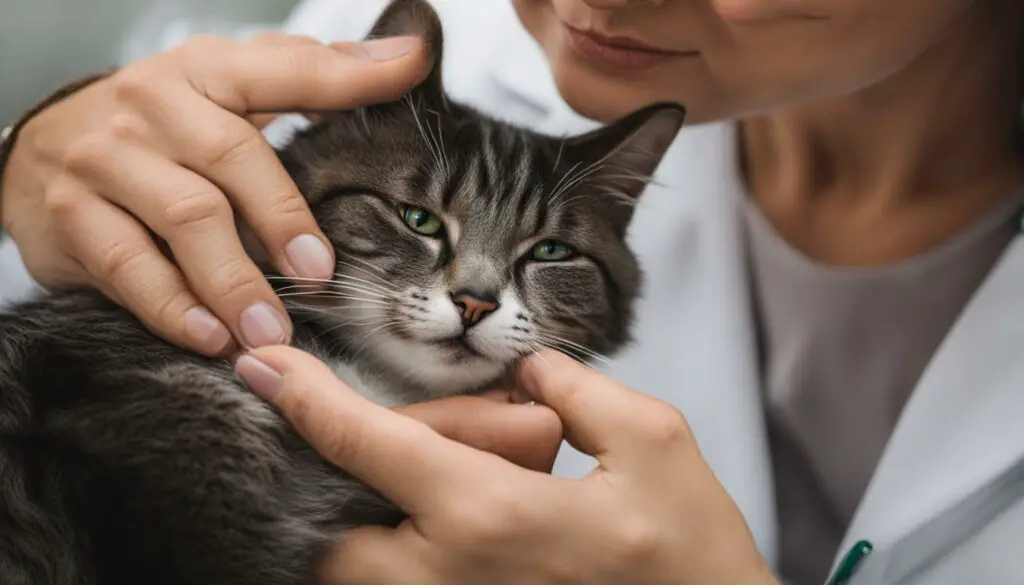
Benefits of Staff Training, Cat-Friendly Facilities, and Effective Communication
When veterinary practices prioritize the improvement of cat handling through staff training, cat-friendly facilities, and effective communication, the benefits are significant. Cats experience reduced stress levels during their visits, which can have a positive impact on their overall well-being. By implementing gentle handling techniques and creating a comfortable environment, cats are more likely to feel at ease, leading to a more positive veterinary experience for both the cats and their owners.
Furthermore, when staff members are knowledgeable and skilled in cat handling, they can build trust with cats and establish a strong patient-veterinarian relationship. This trust allows for more effective examinations, treatments, and procedures, ultimately leading to better outcomes for the cats’ health and overall care.
| Improving Cat Handling in Veterinary Practice | Benefits |
|---|---|
| Staff Training | – Enhanced knowledge of feline behavior – Improved communication with cats – Recognition of signs of stress or fear |
| Cat-Friendly Facilities | – Reduced anxiety and stress in cats – Comfortable waiting areas and hiding spots – Minimized loud noises and strong smells |
| Effective Communication | – Empowered cat owners for proactive care – Tips on handling cats at home – Guidance on creating a stress-free environment |
| Overall Impact | – Reduced stress levels in cats – Trust-building with veterinarians – Better outcomes for cats’ health and care |
By continuously striving to improve cat handling techniques in veterinary practice, we can ensure that cats receive the care they deserve and strengthen the bond between cats and their caregivers. This commitment to enhancing cat welfare ultimately leads to a more positive and fulfilling experience for both cats and their human companions.
The Role of Caretakers in Cat Handling
As cat parents, we have a crucial role in handling our feline companions with care and respect. Adopting a gentle approach is essential to establish trust and build a positive relationship with our cats. By using positive reinforcement techniques, such as treats or praise, during handling, we can create bonding moments and make the experience enjoyable for both cats and their caretakers. Understanding and respecting our cats’ boundaries and preferences is key to fostering a sense of trust and well-being.
Creating a safe and comfortable environment for handling our cats is essential. Providing them with a quiet and calm space, away from loud noises or distractions, can help reduce stress levels. Being patient and allowing our cats to approach us on their own terms can also help establish trust. It is important to remember that every cat is unique, and their comfort levels may vary. By observing their body language and responding accordingly, we can ensure a positive and stress-free handling experience.
Establishing trust with our cats requires consistency and understanding. Taking the time to familiarize ourselves with their preferences, such as favorite scratching spots or types of toys, can help create a bond based on mutual trust and respect. Regular handling sessions, such as gentle brushing or nail trimming, can be an opportunity to strengthen this bond. By approaching these activities with patience and positivity, we can build confidence in our cats and make them feel secure in our care.

Table: Techniques for Gentle Cat Handling
| Technique | Description |
|---|---|
| Positive reinforcement | Using treats or praise to reward desired behavior during handling |
| Gentle touch | Using soft strokes and gentle pressure to create a calming and soothing effect |
| Respecting boundaries | Allowing cats to dictate the pace and level of interaction during handling |
| Providing retreat options | Ensuring cats have access to hiding spots or safe spaces during handling |
By incorporating these gentle handling techniques into our daily interactions with our cats, we can ensure their comfort and well-being. Remember, building trust is an ongoing process, and it takes time and patience. With a gentle approach, we can create a positive and loving bond with our feline companions, enhancing their quality of life and strengthening our relationship.
Understanding Feline Anatomy and Reflexes
Feline anatomy and reflexes play a crucial role in how cats perceive and respond to different handling techniques. One interesting reflex to note is the mother cat reflex, where a cat’s body freezes and spacing out occurs when their scruff is grabbed. This natural response stems from a kitten’s instinct to yield to their mother’s nurturing behavior. However, it’s important to recognize that this reflex may not be as pronounced in adult cats, and they may find scruffing uncomfortable. By understanding these natural reflexes, we can tailor our handling techniques to ensure the utmost comfort and well-being of our feline companions.
When considering feline anatomy, we must also be mindful of the physical and emotional aspects of the cat. Cats have unique physical characteristics such as a flexible spine, retractable claws, and sensitive whiskers. These features help them navigate their surroundings and communicate their intentions. Additionally, cats rely on their senses, including acute hearing and night vision, to perceive the world around them. By recognizing and respecting these physical attributes, we can create a safe and positive environment for our feline friends.
Understanding feline anatomy also extends beyond the physical aspects. Cats are highly perceptive and responsive to their environment. They have keen instincts that guide their behavior, such as territorial instincts and a natural suspicion of unfamiliar stimuli. By respecting their innate behaviors and providing them with options to retreat or maintain control, we can reduce their stress levels and ensure a more harmonious interaction.
| Key Points |
|---|
| Cats have a natural freeze response when their scruff is grabbed, mimicking the nurturing behavior of a mother cat. |
| Adult cats may find scruffing uncomfortable, so alternative handling techniques should be considered. |
| Understanding feline anatomy, both physical and behavioral, allows for safer and more respectful cat handling. |

The Importance of Animal Welfare
When it comes to cat handling, it is essential to prioritize animal welfare and consider ethical considerations. Responsible cat handling practices focus on promoting comfort, minimizing stress, and ensuring the overall well-being of our feline companions. By adopting gentle and respectful handling techniques, we can create a positive environment that fosters trust and strengthens the bond between cats and humans.
Promoting comfort is a key aspect of responsible cat handling. Cats are sensitive creatures, and their well-being can be greatly affected by their environment and how they are handled. By ensuring that their physical and emotional needs are met, we can create a nurturing environment that promotes their overall welfare.
“Responsible cat handling practices focus on promoting comfort, minimizing stress, and ensuring the overall well-being of our feline companions.”
Minimizing stress is another crucial aspect of responsible cat handling. Cats can experience stress during various situations, including veterinary visits, grooming, and transportation. By using techniques that minimize stress, such as providing cats with some control over their environment and avoiding intrusive handling methods, we can help reduce anxiety and create a more positive experience for cats.
Responsible cat handling also involves being mindful of individual cats’ needs and preferences. Each cat is unique and may have different comfort levels and tolerances for handling. By being adaptable and responsive to their cues, we can tailor our handling techniques to suit their specific requirements, ensuring their well-being is always prioritized.
Overall, responsible cat handling is essential for promoting animal welfare. By considering the comfort of cats, minimizing stress, and adopting a mindful and adaptable approach, we can create a positive and nurturing environment that enhances the bond between cats and their caretakers.
Table: Promoting Animal Welfare in Cat Handling
| Aspects | Actions |
|---|---|
| Promoting comfort | Providing a comfortable environment, respecting cats’ boundaries, and using gentle handling techniques. |
| Minimizing stress | Avoiding intrusive handling methods, providing cats with control over their environment, and minimizing stressful situations. |
| Being adaptable | Tailoring handling techniques to suit individual cats’ needs and preferences, being responsive to their cues. |
Cat Communication and Building Trust: Understanding Body Language for a Strong Patient-Cat Relationship
Effective communication is essential to building a strong relationship with our feline companions. Cats communicate primarily through their body language, using various subtle cues to express their emotions and needs. By understanding and interpreting these signals, we can establish trust and create a positive patient-cat relationship.
Cat body language can be diverse, ranging from subtle movements to more obvious behaviors. For example, a relaxed cat will have a soft, loose posture, with their tail held in a natural position. On the other hand, a stressed or fearful cat may exhibit defensive behaviors, such as flattening their ears, dilated pupils, or a puffed-up tail. By observing and recognizing these signals, we can adjust our approach and provide the right level of support and care.
Trust-building is a crucial aspect of cat handling. Cats need to feel safe and secure in their environment, and trust is earned through positive interactions and respect for their boundaries. Patience and consistency are key when building trust with cats, as they may take time to adjust and feel comfortable in new situations. By implementing gentle handling techniques, rewarding them with treats or praise, and avoiding forceful actions, we can foster a sense of trust and create a nurturing patient-cat relationship.
Understanding Cat Body Language: Key Signals to Look For
When communicating with cats, it is important to pay attention to their body language. Here are some common signals and what they may indicate:
- Tail position: A relaxed cat will have their tail in a neutral or slightly raised position, while a swishing or puffed-up tail may indicate agitation or fear.
- Ear position: Ears held forward or slightly to the side indicate a calm cat, while flattened ears may suggest fear or aggression.
- Pupil dilation: Dilated pupils can indicate arousal or stress, while constricted pupils may suggest relaxation or contentment.
- Slow blinking: Cats often communicate affection and trust through slow blinking, so reciprocating with a gentle blink can help strengthen the bond.
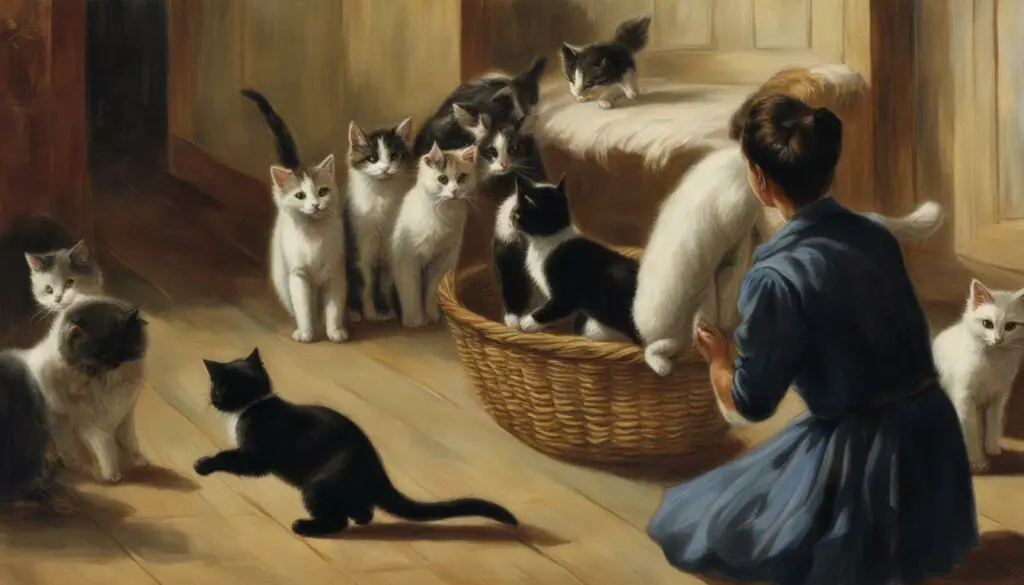
“Understanding and respecting cat body language is key to building trust and forming a strong patient-cat relationship. By paying close attention to their signals and responding appropriately, we can create a safe and comfortable environment for our feline friends.” – Jane Smith, Feline Behavior Specialist
Enhancing Communication and Trust: Tips for Positive Cat Handling
- Respect personal space: Allow cats to approach and initiate contact on their terms, respecting their need for personal space.
- Use gentle, slow movements: Abrupt or sudden movements can startle or stress cats. Instead, approach them calmly and slowly.
- Provide positive reinforcement: Reward cats with treats, praise, or playtime when they exhibit desired behaviors, reinforcing trust and positive associations.
- Establish a routine: Cats feel more secure when they have a predictable routine and know what to expect from their environment and caretakers.
Summary
Understanding cat communication and body language is essential for building trust and forming a strong patient-cat relationship. By observing and interpreting their signals, such as tail position, ear position, and pupil dilation, we can adjust our approach to meet their needs and create a safe and comfortable environment. Gentle handling techniques, positive reinforcement, and respect for their personal space are key to enhancing communication and building trust with our feline companions. By prioritizing effective communication and trust-building, we can strengthen the bond between cats and their caretakers, ultimately contributing to their overall well-being.
Cat Handling as an Ongoing Process
When it comes to cat handling, there is no one-size-fits-all approach. Each cat is unique, with individual needs and preferences. That’s why it’s crucial to approach cat handling as an ongoing process of continuous improvement. By being responsive to each cat’s specific needs, we can ensure their utmost comfort and well-being.
A responsive approach to cat handling means adapting our techniques to meet the individual needs of each cat. What works for one cat may not work for another, so it’s important to be flexible and adaptable. By continuously learning and refining our cat handling skills, we can provide the best possible care and support to our feline friends.
Understanding the importance of individual needs in cat handling is key. Cats have unique personalities and comfort levels, and it’s essential to respect their boundaries. By tailoring our techniques to each cat’s preferences, we can create a more positive and comfortable experience for them.
Adaptable techniques, such as using towel wrapping or conducting exams while cats remain in their carriers, can help reduce stress and anxiety during handling. By continuously evaluating and improving our approach to cat handling, we can ensure the highest level of well-being for our feline companions.
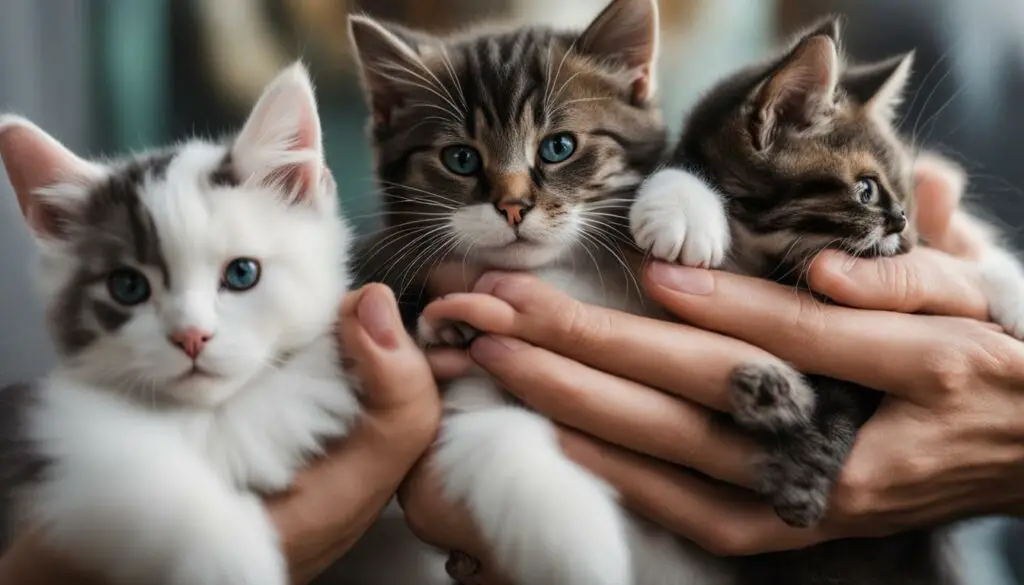
Table: Adaptable Techniques for Cat Handling
| Technique | Description |
|---|---|
| Towel wrapping | Wrapping the cat in a towel to provide comfort and security during handling. |
| Conducting exams in carriers | Performing examinations while the cat remains in their carrier to reduce stress. |
| Positive reinforcement | Using treats or praise to encourage desired behavior and create a positive association with handling. |
| Gentle touch | Using a gentle touch and minimizing restraint to make cats feel more comfortable. |
By continuously striving for improvement, implementing a responsive approach, and considering each cat’s individual needs, we can create a positive and comfortable environment for cat handling. Through adaptable techniques and a commitment to their well-being, we can strengthen our bond with our feline companions and provide them with the care they deserve.
The Benefits of Positive Cat Handling
When it comes to handling cats, adopting positive techniques can have numerous benefits for both cats and their caregivers. By prioritizing positive cat handling, we can reduce stress and enhance the overall well-being of our feline friends. This approach creates a nurturing environment that fosters a strong bond between humans and their cats.
Positive cat handling techniques contribute to more positive veterinary experiences. Cats feel more comfortable and are less likely to exhibit aggressive behaviors when they are handled gently and respectfully. This improves the overall veterinary experience for both the cat and the veterinary staff, creating a smoother and more successful visit.
By focusing on positive cat handling, we can also promote the long-term well-being of our cats. Stress reduction is a key aspect of positive handling, and by minimizing stress during handling, we can help prevent the development of behavior problems and improve our cats’ overall quality of life. Positive handling techniques build trust and enhance the bond between cats and their caregivers, creating a positive and enriching relationship.
Table: Comparing Positive Cat Handling vs. Traditional Handling Techniques
| Positive Cat Handling | Traditional Handling Techniques |
|---|---|
| Minimizes stress | May cause stress and fear |
| Enhances well-being | Can lead to anxiety and aggression |
| Builds trust | May erode trust and damage the bond |
| Creates positive veterinary experiences | May result in difficult and traumatic visits |
Overall, positive cat handling techniques are essential for promoting the well-being of our feline companions. By reducing stress, enhancing the bond, and creating positive experiences, we can ensure that our cats feel safe, comfortable, and loved.
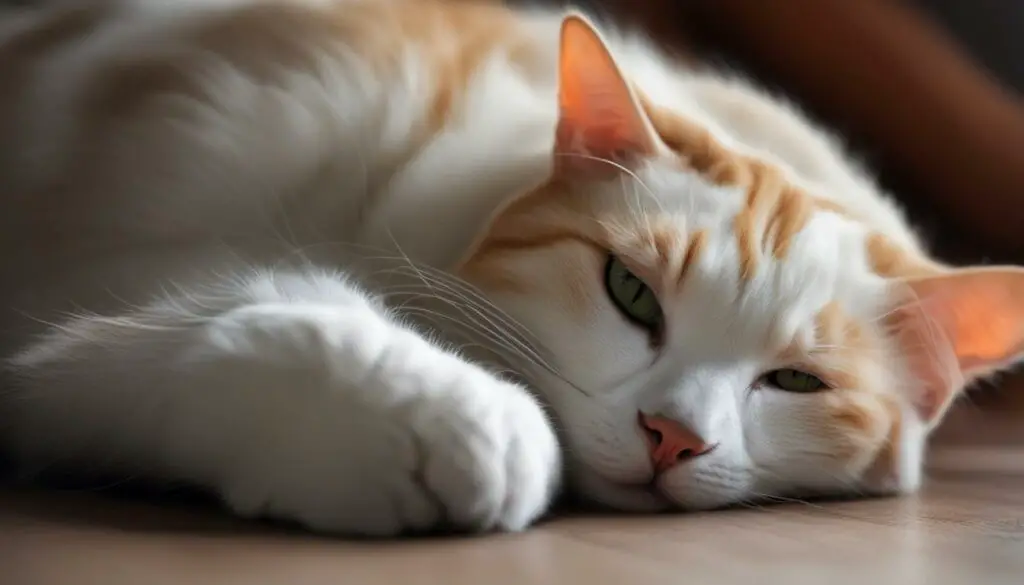
Conclusion
After examining different perspectives on picking up cats by scruff, it is clear that alternative handling techniques prioritize cat welfare, stress reduction, and the development of a positive relationship between humans and cats. While scruffing may have its place in specific situations, it is essential to consider the individual needs and preferences of each cat when determining the most appropriate handling method.
By understanding feline behavior, implementing Fear Free methodologies, and promoting gentle and respectful handling, we can create a more positive and comfortable experience for cats. This approach not only enhances their overall well-being but also strengthens the bond between cats and their caretakers.
With a continuous focus on improving communication, trust-building, and understanding of cat anatomy and reflexes, we can refine our cat handling skills and provide the best possible care for our feline friends. By prioritizing cat welfare, stress reduction, and positive handling experiences, we create a nurturing environment that fosters a strong and lasting relationship with our beloved cats.
In conclusion, adopting alternative handling techniques that prioritize cat welfare, stress reduction, and the development of a positive relationship is crucial. Let us continue to explore, learn, and refine our cat handling skills to ensure the utmost comfort and well-being of our feline companions.
FAQ
Is scruffing a safe method to pick up cats?
Scruffing can be safe for certain situations and with certain cats, but it is not appropriate or effective for all cats. It is important to consider alternative handling techniques that prioritize cat welfare and minimize stress.
What are some alternative methods for cat handling?
Alternatives to scruffing include wrapping cats in towels, using Fear Free methodologies, and conducting exams while cats are still in their carriers. These methods aim to create a more positive and comfortable experience for cats during veterinary visits.
How can I improve my cat’s comfort during handling?
By understanding feline behavior, respecting their boundaries, and using positive reinforcement techniques, you can build trust and enhance your cat’s overall well-being during handling.
What are the negative effects of scruffing on cats?
Scruffing can potentially escalate a cat’s stress levels and lead to anxiety and fear. It may trigger a stress response that manifests as aggression. By avoiding scruffing and providing cats with some sense of control over the situation, we can minimize their stress levels and promote better overall well-being.
How can I create a more positive veterinary experience for my cat?
Prioritize staff training, create cat-friendly facilities, and improve your understanding of feline behavior. By providing training on alternative handling techniques and modifying the physical environment to make it more comfortable for cats, you can contribute to a positive experience for your cat at the vet.

